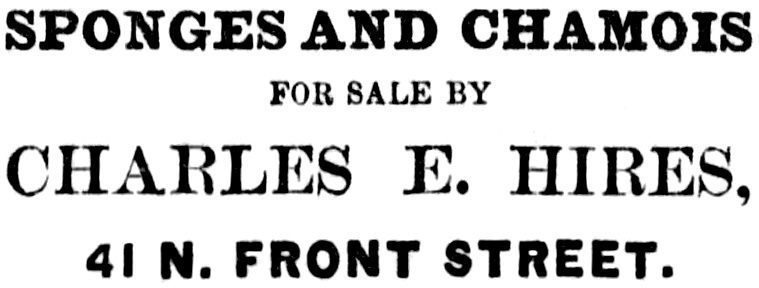1876
IT HAPPENED IN…1876
General George A. Custer and 265 men of the
Seventh Cavalry lost the Battle of the Little Big Horn in Montana to
Sitting Bull’s Sioux Indians.
Colorado was admitted to the Union as the 38th
state.
Several libraries banned
The Adventures of Tom Sawyer
as unfit for young readers.
Thomas A. Edison invented a mimeograph that
employed a stencil for making impressions.
Alexander Graham Bell was awarded the first U.S.
patent for the telephone.
John Harvey Kellogg, a Seventh Day Adventist,
began developing new types of flaked cereals claiming that if
included in a vegetarian diet they would help to curb the sex drive.
The Republicans nominated Rutherford B. Hayes of
Ohio for president, and the Democrats nominated Samuel J. Tilden of
New York.
Newly introduced
products and inventions included arc lighting, carpet sweepers,
internal combustion engines, refrigerators, and Heinz ketchup.
Charles E. Hires placed this advertisement in the
Philadelphia Inquirer
newspaper less than a month before the
Centennial International
Exhibition of 1876 opened (note he included no mention of Hires
Root Beer):
(Figure
1876-01,
Philadelphia Inquirer, April 18, 1876)
“The International Exhibition of Arts, Manufactures
and Products of the Soil and Mine,” took place May 10 thru November 10,
1876 in Philadelphia, Pennsylvania.
Popularly referred to as the “Centennial International Exhibition
of 1876,” this event was the first official world’s fair held in the
United States and timed to celebrate the 100th anniversary of
the signing of the Declaration of Independence.
New inventions, technologies, and products introduced
at the Centennial Exhibition included the telephone, typewriter,
air-powered tools, bananas, popcorn, and Heinz ketchup.
As for soft drinks, according to
Organization in the Soft Drink
Industry – A History of the American Bottlers of Carbonated Beverages,
authored by John J. Riley, Secretary of the ABCB, in 1946:
Some indication of the acceptance of carbonated
drinks by the American consumer at the time is shown by the sale of the
concession, for $50,000, to Charles Lippincott & Co. of Philadelphia and
James W. Tufts of Boston, for exclusive sale of soda water at the
Centennial Exhibition in Philadelphia in 1876.
John J. Riley’s 1946 history of the ABCB makes no mention of Charles E. Hires in conjunction with the Centennial International Exhibition of 1876.
Contradicting himself, in 1958
John J. Riley authored A History
of the American Soft Drink Industry and stated:
Charles E. Hires exhibited his package of dried roots
and herbs, for making ‘Hires’ root beer, at the Centennial Exhibition in
Philadelphia in 1876, and sampled the finished drink.
Here, however, is how John J. Riley footnoted his
1958 statement:
6. (COMPANIES; SOURCES) Many of the major soft drink
manufacturers have published historical data concerning their particular
product and company. Some
of it has appeared in the trade papers, and in their own house organs,
and is usually made available upon request.
Between 1946 and 1958 John J. Riley apparently fell victim to Hires
Company marketing hype. Although
Riley and numerous other sources repeatedly claim Charles E. Hires
demonstrated and either gave away or sold samples of Hires Root Beer at
the 1876 Centennial Exhibition, this is a myth fabricated for marketing
purposes. There is no
documented evidence Charles E. Hires exhibited at or had any involvement
whatsoever with the 1876 Centennial Exhibition.
CHARLES E. HIRES’ INTRODUCTION TO ROOT BEER
Charles E. Hires included the following comments in
“Some Advertising Reminiscences 1869-1913,” an article he authored for
the July 24, 1913 issue of
Printers’ Ink:
Centennial year, I think – my wife and I were
boarding at a farmhouse in the country, over in Jersey.
The farmer’s wife was accustomed to gather teaberry leaves,
sassafras bark and berries, and to steep them, making a tea.
The result, when fermented with yeast, was called “homemade root
beer.” I conceived the idea
of putting a similar product on the market, and after a great deal of
experimenting I hit upon
what I considered the right combination of roots and barks to produce a
flavor which would please at the moment and would also send the customer
back for more. For some
time I sold the dry herbs in the package, with directions to the
purchaser to steep them, later adding the yeast and sugar just as it was
done by the farmer’s wife in Jersey.
Later, however, to save the customer the trouble of boiling and
straining the dry herbs, I put it up in the form of Hires Root Beer
Extract, just as it is still sold today.
Charles E. Hires and Clara K. Smith were married
January 5, 1875. Hires’
reference to “Centennial year” (1876) suggests they were not in New
Jersey on their honeymoon, dispelling yet another myth about the origin
of Hires Root Beer. Also
note Hires mentioned being served “homemade root beer,” a clue that the
various stories about how Hires Root Beer was named are also myths and
he simply added his name to the existing terminology for the beverage.
Lastly, Hires’ reference to “after a great deal of experimenting”
suggests he was working on perfecting the Hires Root Beer formula but
not selling it during 1876.
When Charles E. Hires placed this 2.375” x .25”
advertisement on the front page of Philadelphia’s
Public Ledger newspaper the
1876 Centennial Exhibition was under way and still there was absolutely
no mention of Hires Root Beer.
Sponges and Chamois Skins.
C. E. Hires, Importer, No. 123 North Front Street
(Figure
1876-02, Public
Ledger, September 16, 1876, re-typed for clarity)
Hires ran the following advertisement in the November
24, 1876 issue of Philadelphia’s
The Times newspaper.
The 1876 Centennial Exhibition
had ended two weeks earlier and once again he included no mention of
Hires Root Beer.
(Figure
1876-03, The
Times, November 24, 1876)
Charles E. Hires discussed the origin of Hires Root
Beer once again for “The Story of Hires,” an article first published in
the April, 1921 issue of the
Printers’ Ink Monthly journal:


